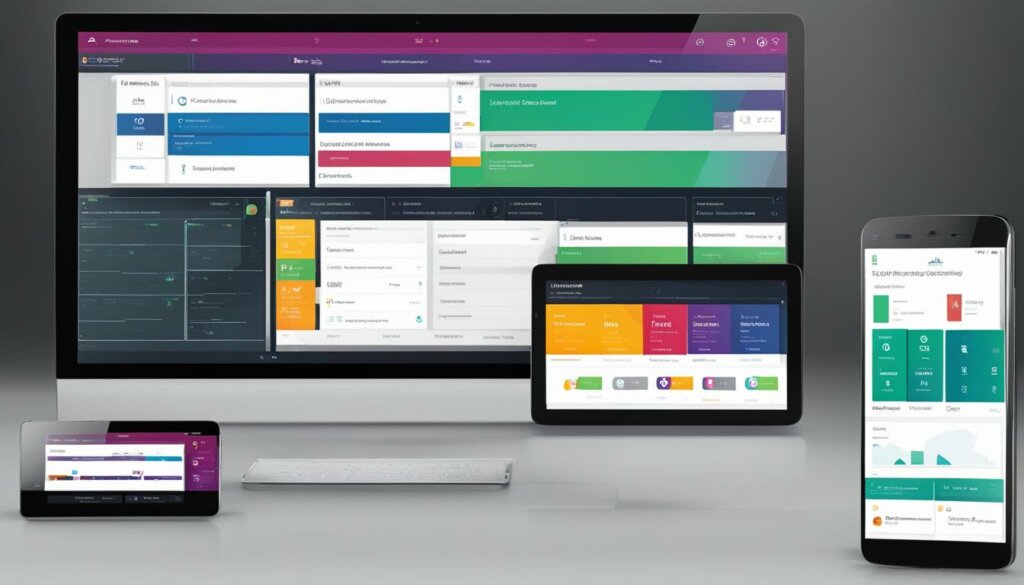Table of Contents
Mobile device management (MDM) plays a crucial role in today’s rapidly evolving business landscape. With the exponential growth of enterprise mobility, organizations are in need of effective strategies to manage their mobile devices, ensure device security, and maximize productivity. In this article, we will explore various MDM strategies that can help companies achieve seamless device management and enhance their overall digital mobility.
Mobile device management, also known as MDM, encompasses the implementation of policies and technologies to manage and secure mobile devices within an organization. It involves device provisioning, setting up device policies, and ensuring device security. By effectively managing mobile devices, organizations can mitigate security risks, improve productivity, and streamline their operations.
Device security is a key aspect of MDM, as mobile devices are susceptible to various security threats. Implementing robust security measures helps protect sensitive data and ensures compliance with industry regulations. This includes deploying comprehensive security solutions, enforcing device policies, and regularly evaluating and updating security protocols.
Effective MDM strategies also consider enterprise mobile management solutions. These solutions provide organizations with the tools and capabilities to manage and control mobile devices across their entire network. By adopting user-centric, cloud-based platforms, organizations can empower their employees to work seamlessly across multiple devices, ensuring a consistent and secure user experience.
Furthermore, endpoint management is an essential consideration in MDM strategies. With the rise of the Internet of Things (IoT), organizations need to manage not only traditional devices such as smartphones and tablets but also IoT devices like wearables and industrial equipment. By incorporating endpoint management into their MDM strategy, organizations can maximize business processes and leverage valuable data generated by these devices.
To create an effective MDM strategy, organizations should establish their requirements and goals, deploy user-centric platforms, consider endpoint management, employ comprehensive security solutions, and continuously evaluate analytics to enhance user experience. By adopting these strategies, companies can effectively manage their mobile devices, enhance security, and drive productivity in today’s digital landscape.
Establish Organizational Requirements and Goals
Before implementing a mobile device management (MDM) strategy, organizations should first establish their requirements and goals. This involves considering various factors such as security needs, compliance requirements, network and service management considerations, and reporting capabilities. By clearly defining these organizational requirements, businesses can ensure that their MDM strategy is tailored to their specific needs.
Additionally, it is crucial for organizations to define their goals when it comes to MDM. These goals can include enhancing mobile device security, improving user accessibility, or boosting overall productivity. By aligning the MDM strategy with these goals, organizations can create a framework that supports their desired outcomes.
Ultimately, establishing organizational requirements and goals is the foundation for an effective MDM strategy. It allows businesses to build a framework that meets their specific needs and aligns with their overall objectives.
| Organizational Requirements | Goals |
|---|---|
| Security needs | Enhanced mobile device security |
| Compliance requirements | Ensure regulatory compliance |
| Network and service management considerations | Efficient network and service management |
| Reporting capabilities | Comprehensive reporting for analysis and decision-making |
Deploy a User-Centric, Cloud-Based Platform
A successful mobile device strategy requires a user-centric, cloud-based platform. As employees bring their own devices to work, it is important to provide them with a seamless and secure experience across multiple devices. A cloud-based platform allows for easy access to work-related content from any device, increasing adoption and productivity. By prioritizing the user experience, organizations can empower employees to be more productive and efficient.
Cloud-based platforms offer a range of benefits for mobile device management. First and foremost, they provide a centralized solution that can be accessed from anywhere, eliminating the need for complex on-premise infrastructure. This enables organizations to scale their device management capabilities rapidly and efficiently.
By deploying a cloud-based platform, organizations can leverage the power of the cloud to deliver a consistent user experience across devices. Employees can seamlessly access their work-related apps and data, securely collaborate with colleagues, and easily switch between devices without any disruptions. This user-centric approach enhances productivity and flexibility in today’s mobile workforce.
In addition, a cloud-based platform offers enhanced security features. These platforms typically employ robust encryption protocols and multi-layered authentication methods to protect sensitive company data. They also provide remote management capabilities, allowing IT teams to remotely track, lock, or wipe devices in case of loss or theft, ensuring the security of corporate information.

Benefits of a User-Centric, Cloud-Based Platform
There are several key benefits of deploying a user-centric, cloud-based platform as part of a mobile device strategy:
- Enhanced productivity: By providing employees with seamless access to work-related content across devices, a cloud-based platform enables them to be more productive and efficient in their tasks.
- Improved collaboration: Cloud-based platforms facilitate easy and secure collaboration between team members, enabling them to work together on projects in real-time, regardless of their location.
- Scalability and flexibility: With a cloud-based platform, organizations can easily scale their device management capabilities as their workforce and device count grows. It also offers flexibility to accommodate different device types and operating systems.
- Enhanced security: Cloud-based platforms provide advanced security features, such as encryption and multi-factor authentication, to protect company data from unauthorized access or breaches.
- Cost-effectiveness: By eliminating the need for on-premise infrastructure and maintenance, a cloud-based platform offers a cost-effective solution for mobile device management.
Overall, deploying a user-centric, cloud-based platform is crucial for organizations looking to effectively manage their mobile devices. It not only enhances productivity and collaboration but also provides robust security measures and scalability for future growth.
Consider Endpoint Management to Maximize Business Processes
The exponential growth of the Internet of Things (IoT) has revolutionized the way organizations operate. In today’s interconnected world, it is crucial for businesses to consider endpoint management as part of their mobile device management (MDM) strategy. Endpoint management goes beyond traditional device management by encompassing not only computers, smartphones, and tablets but also a wide range of IoT devices, such as industrial equipment, sensors, and wearables. By incorporating these endpoints into their MDM strategy, organizations can optimize their business processes and unlock new opportunities for growth.
Managing IoT devices through an MDM strategy offers numerous benefits. Firstly, it enables organizations to streamline their operations by centralizing the management and control of diverse devices. This allows for standardized security measures, firmware updates, and application deployments, ensuring a consistent experience across the entire IoT ecosystem. Secondly, endpoint management enhances the security of the IoT infrastructure. By closely monitoring and enforcing security policies on all endpoints, organizations can mitigate the risk of cyberattacks and protect sensitive data. Finally, leveraging endpoint management data can provide valuable insights for improving business processes, identifying operational inefficiencies, and making data-driven decisions.
Table:
| Endpoint Management Benefits | Explanation |
|---|---|
| Streamlined Operations | Centralized management and control of diverse devices |
| Enhanced Security | Close monitoring and enforcement of security policies on all endpoints |
| Improved Business Processes | Valuable insights for optimizing operations and making data-driven decisions |
By considering endpoint management as an integral part of their MDM strategy, organizations can harness the full potential of the IoT, optimize their operations, and stay ahead in a rapidly evolving digital landscape.
Employ a Comprehensive Security Solution
To ensure the effectiveness of mobile device management strategies, organizations must prioritize the implementation of a comprehensive security solution. This solution aims to protect devices, data, and networks from potential threats and vulnerabilities. By incorporating robust security measures, companies can mitigate risks and maintain the integrity of their mobile ecosystem.
A comprehensive security solution for mobile device management encompasses various aspects. Firstly, continuous protection against threats is essential. This includes implementing anti-malware software, conducting regular vulnerability assessments, and keeping devices up to date with the latest security patches and updates.
Encryption is another crucial element of a comprehensive security solution. By encrypting data stored in the cloud and on devices, organizations can ensure the confidentiality and integrity of sensitive information. Additionally, monitoring and mitigating cybersecurity threats across devices is crucial in identifying and responding to potential breaches or suspicious activities in real time.
Enhanced identity capabilities should also be part of a comprehensive security solution. Two-factor authentication and access management provide an additional layer of security, ensuring that only authorized individuals can access sensitive data and resources. By enforcing these measures, organizations can significantly reduce the risk of unauthorized access to company data or systems.
Quotes:
“A comprehensive security solution is fundamental to effective mobile device management strategies. It safeguards devices, data, and networks from potential threats, ensuring the integrity and security of an organization’s mobile ecosystem.”
Table:
| Components of a Comprehensive Security Solution | Benefits | |
|---|---|---|
| Continuous protection against threats | – Mitigates risks | – Maintains device and data integrity |
| Data encryption | – Ensures confidentiality | – Protects against data breaches |
| Cybersecurity threat monitoring and mitigation | – Identifies and responds to potential breaches | – Prevents unauthorized access |
| Enhanced identity capabilities | – Provides an additional layer of security | – Reduces the risk of unauthorized access |
Implementing a comprehensive security solution in mobile device management strategies is vital for organizations to safeguard their devices, data, and networks. By prioritizing continuous protection, data encryption, threat monitoring, and enhanced identity capabilities, companies can mitigate risks and maintain a secure mobile ecosystem.
Continually Evaluating Analytics to Enhance User Experience
One of the key factors in creating an effective mobile device management (MDM) strategy is the ability to improve the user experience. By evaluating analytics and user behavior data, organizations can gain valuable insights into how employees interact with their mobile devices and identify areas for improvement. This data-driven approach allows for targeted enhancements that can increase productivity and overall satisfaction.
Analytics provide organizations with a wealth of information regarding mobile device usage patterns, such as the most frequently used applications, the duration of device usage, and even the preferred communication channels. By analyzing this data, organizations can tailor their MDM strategy to better accommodate these usage patterns and optimize device configurations. For example, if employees primarily use messaging apps for communication, organizations can prioritize the security and functionality of these applications within their MDM strategy.
The data collected through analytics can also help organizations identify any pain points or bottlenecks in their MDM strategy. For instance, if employees frequently encounter issues with accessing certain applications or experience slow device performance, organizations can use analytics to pinpoint the root causes and implement targeted solutions. This iterative process of evaluating analytics and making improvements ensures that the MDM strategy remains flexible and adaptable to the ever-evolving needs of the workforce.
By continuously evaluating analytics, organizations can stay ahead of emerging trends and technologies, adapting their MDM strategy to accommodate new devices, software updates, and user preferences. This proactive approach to user experience optimization not only enhances employee satisfaction but also contributes to increased productivity and overall efficiency within the organization.
| Benefits of Evaluating Analytics for MDM | Insights Gained |
|---|---|
| Enhanced User Experience | Identify usage patterns, preferred applications, and communication channels. |
| Improved Performance | Pinpoint and resolve bottlenecks, slow performance, and application accessibility issues. |
| Adaptability | Stay ahead of emerging trends and technologies, ensuring the MDM strategy remains up-to-date. |
| Increased Productivity | Optimize device configurations and prioritize functionality based on user behavior. |
| Efficiency | Continuously refine the MDM strategy to maximize productivity and streamline workflows. |
Importance of Mobile Device Management
Mobile device management (MDM) plays a critical role in the effective management of mobile devices within IT environments. As the use of mobile devices continues to grow, organizations face the challenge of ensuring data security, compliance, and control over these devices. MDM provides a comprehensive solution that allows IT teams to manage and safeguard mobile devices, protecting sensitive data and intellectual property.
One of the key benefits of implementing an MDM strategy is the ability to remotely manage devices. IT teams can easily deploy updates, install applications, and enforce security policies across a fleet of devices, irrespective of their location. In case of lost or stolen devices, MDM enables remote lock and wipe actions, preventing unauthorized access to sensitive information. This not only bolsters data security but also ensures compliance with company regulations and industry standards.
MDM also offers tracking capabilities, allowing organizations to keep tabs on their mobile devices. Through device inventory management, IT teams can monitor the status and location of devices, ensuring accountability and reducing the risk of loss or theft. Additionally, MDM solutions provide enhanced security measures such as encryption, two-factor authentication, and access management, further fortifying the protection of company data.
Benefits of Mobile Device Management:
- Enhanced data security and compliance
- Remote management and control of devices
- Tracking capabilities for accountability
- Comprehensive security measures
- Increased productivity and efficiency
By implementing an effective MDM strategy, organizations can maintain control over their mobile devices, ensuring the integrity of their IT environments and safeguarding sensitive data against potential threats.

Creating an MDM Strategy
Developing an effective Mobile Device Management (MDM) strategy is crucial for organizations to efficiently manage and secure their mobile devices. An MDM strategy involves enrolling mobile devices, implementing configurations and restrictions, and executing remote actions through MDM software. It is important to align the strategy with the overall goals and objectives of the organization’s IT environment, taking into consideration factors such as device ownership (company-issued or personal), use cases (personal vs. shared devices), and additional device management solutions.
To create a successful MDM strategy, organizations should start by enrolling mobile devices into a centralized management system. This allows for easy device onboarding, tracking, and monitoring. Implementing configurations and restrictions ensures that devices are compliant with security policies and adhere to company guidelines. These measures include password requirements, application whitelisting or blacklisting, and device feature restrictions.
Executing remote actions, such as locking, wiping, or selectively deleting data on lost or stolen devices, is an integral part of an MDM strategy. This enables IT teams to protect sensitive information and prevent unauthorized access. Remote actions can be initiated through MDM software, allowing for swift and efficient device management, even when devices are not in physical proximity to IT teams.
Implementing an MDM strategy is essential for organizations to effectively manage and secure their mobile devices. It allows for centralized control, ensuring that devices are compliant with security policies and company guidelines. With remote actions, IT teams can protect sensitive information and mitigate risks associated with lost or stolen devices.
Regular assessment and evaluation of the MDM strategy are necessary to ensure its effectiveness. By analyzing key performance indicators (KPIs) such as device compliance rates, application usage, and security incidents, organizations can identify areas for improvement and optimize their MDM approach. Continuous monitoring and adjustment of the strategy are essential as technology and security landscapes evolve.
Creating an MDM strategy requires collaboration between IT teams, stakeholders, and end-users. It is important to consider the needs and preferences of employees who will be using the mobile devices, as well as the organization’s overall IT goals. By involving all relevant parties in the strategy creation process, organizations can ensure that the MDM approach is comprehensive, effective, and aligned with their specific requirements.
| Key Steps for Creating an MDM Strategy | Benefits |
|---|---|
| Enroll mobile devices into a centralized management system | Streamline device onboarding, tracking, and monitoring |
| Implement configurations and restrictions | Ensure compliance with security policies and company guidelines |
| Execute remote actions through MDM software | Protect sensitive information and prevent unauthorized access |
| Regularly assess and evaluate the strategy | Identify areas for improvement and optimize MDM approach |
| Involve IT teams, stakeholders, and end-users | Create a comprehensive, effective, and aligned MDM strategy |
Key Features of MDM Software
The use of Mobile Device Management (MDM) software is crucial for organizations looking to effectively manage and secure their mobile devices. MDM software offers a range of key features that enable organizations to efficiently control and monitor their device inventory, implement restrictions and configurations, manage applications and content, enforce policies, ensure device and data security, automate processes, and perform remote maintenance.
Table:
| Key Features | Description |
|---|---|
| Device Inventory | Allows organizations to monitor and track their mobile devices, providing visibility into device status, location, and usage. |
| Restrictions and Configurations | Enables organizations to enforce policies and configure settings on mobile devices, ensuring compliance with security standards and optimizing device performance. |
| Application and Content Management | Facilitates the distribution and management of applications and content across devices, ensuring that users have access to the resources they need for their work. |
| Device and Data Security | Provides robust security measures to protect devices and data from threats, including encryption, remote locking, and data wiping capabilities. |
| Policy Enforcement | Allows organizations to enforce security policies and configurations, ensuring that devices are used in accordance with company guidelines. |
| Automation | Enables organizations to automate various device management tasks, such as device enrollment, software updates, and compliance checks, saving time and effort for IT teams. |
| Remote Maintenance | Enables organizations to remotely diagnose and resolve device issues, perform maintenance tasks, and provide support to users, reducing the need for physical intervention. |
With these key features, MDM software empowers organizations to effectively manage their mobile device ecosystems, ensuring that devices are secure, compliant, and optimized for productivity. By leveraging MDM software, organizations can streamline device management processes, enhance data security, and improve overall operational efficiency.
Choosing the Best MDM Software
When it comes to selecting the best Mobile Device Management (MDM) software for your organization, there are several factors to consider. From supported operating systems to key features and deployment options, making the right choice is crucial for effective device management. Here are some important considerations to help you make an informed decision.
Supported Operating Systems
Before choosing an MDM software, it’s essential to ensure that it supports the operating systems used by your organization. Whether you have a mix of iOS, Android, or Windows devices, the software should be compatible across all platforms. This allows for seamless integration and management of different devices, ensuring consistency and efficiency in your mobile device management strategy.
Key Features
Identifying the key features that align with your organization’s policies and needs is vital. Consider features such as device inventory management, restrictions and configurations, application and content management, device and data security measures, policy enforcement, automation, and remote maintenance capabilities. Assessing the importance of each feature based on your requirements will help you prioritize and choose the MDM software that best meets your organization’s needs.
Deployment Options: Cloud-Based vs. On-Premise
Another important decision to make is whether to opt for a cloud-based or on-premise MDM solution. A cloud-based solution offers the advantage of easy scalability, as it eliminates the need for infrastructure setup and maintenance. It also provides remote access and simplified updates. On the other hand, an on-premise solution may be preferred for organizations with strict data privacy and compliance requirements, as it allows for more control over sensitive information. Consider your organization’s preferences and requirements before deciding on the deployment option.
| Factors to Consider | Cloud-Based Solution | On-Premise Solution |
|---|---|---|
| Scalability and Ease of Updates | High | Medium |
| Data Privacy and Compliance Control | Medium | High |
| Infrastructure Setup and Maintenance | Low | Medium |
| Remote Access | High | Medium |
By carefully considering these factors – supported operating systems, key features, and deployment options – you can choose the best MDM software for your organization. Remember, an effective MDM solution will empower your IT team to efficiently manage and secure your mobile devices, ensuring data security and compliance across the organization.

Conclusion
Implementing an effective MDM strategy is essential for organisations to manage and secure their mobile devices. By establishing requirements and goals, deploying a user-centric platform, considering endpoint management, employing comprehensive security measures, evaluating analytics, and choosing the right MDM software, organisations can achieve effective mobile device management and enhance productivity, security, and overall digital mobility.
Mobile device management (MDM) plays a crucial role in the ever-growing landscape of mobile devices in the corporate world. The exponential growth of Enterprise Mobility Management (EMM) highlights the need for effective MDM strategies. With the revenues for the EMM market expected to reach $1.8 billion by the end of 2017 and more than $3.3 billion annually by 2021, it is clear that organisations cannot afford to overlook this vital aspect of their operations.
By establishing their requirements and goals, organisations can align their MDM strategy with their specific needs. Deploying a user-centric, cloud-based platform allows for a seamless and secure experience across multiple devices, enabling employees to be more productive and efficient. Considering endpoint management, including IoT devices, maximises business processes and opens new opportunities for data analysis and application. Employing a comprehensive security solution ensures the safety of devices and data, while continually evaluating analytics enhances the user experience and drives continuous improvement.
Choosing the right MDM software is crucial for effective mobile device management. Considering factors such as supported operating systems, key features, and budget allows organisations to make an informed decision. Whether opting for a cloud-based or on-premise solution, selecting the most suitable MDM software lays the foundation for a successful MDM strategy.
FAQ
What is the importance of mobile device management (MDM) in organizations?
MDM enables IT teams to effectively manage and control mobile devices, ensuring data security and compliance. It allows for remote actions, tracking, and increased compliance with company regulations.
How should organizations establish their requirements and goals for MDM?
Organizations should consider their security and compliance needs, network and service management considerations, and reporting capabilities. They should also define their goals, such as increased mobile device security or improved productivity.
Why is deploying a user-centric, cloud-based platform important for MDM?
A user-centric, cloud-based platform provides a seamless and secure experience across multiple devices, increasing adoption and productivity. It allows for easy access to work-related content from any device.
What is endpoint management and why should it be considered in MDM strategies?
Endpoint management involves managing not only computers, smartphones, and tablets but also other IoT devices. By incorporating these endpoints into the MDM strategy, organizations can make their processes smoother, more secure, and more efficient.
What should a comprehensive security solution include for effective MDM?
A comprehensive security solution should provide continuous protection against threats, encrypt data stored in the cloud, and monitor and mitigate cybersecurity threats across devices. Enhanced-identity capabilities and access management should also be included.
How can analytics help improve the user experience in MDM?
Analytics and user behavior data can provide insights into how employees use their mobile devices for work-related tasks, helping identify areas for improvement. By leveraging data to enhance the user experience, organizations can increase productivity and overall satisfaction.
What is the significance of mobile device management in companies?
Mobile device management is crucial for organizations as the use of mobile devices continues to grow. It helps manage and secure mobile devices, ensuring data security, compliance, and increasing productivity.
How can organizations create an effective MDM strategy?
Creating an MDM strategy involves enrolling mobile devices, implementing configurations and restrictions, and executing remote actions through MDM software. The strategy should align with organizational goals and consider factors such as device ownership and additional device management solutions.
What are the key features of MDM software?
Key features of MDM software include device inventory, restrictions and configurations, application and content management, device and data security, policy enforcement, automation, and remote maintenance for software updates and troubleshooting.
How can organizations choose the best MDM software?
When selecting MDM software, organizations should consider factors such as supported operating systems, key features that align with their needs and policies, size of the company, and budget. The choice between a cloud-based or on-premise solution should also be considered.
Source Links
- https://www.wirelesswatchdogs.com/blog/choosing-the-best-mobile-device-management-strategy
- https://www.ninjaone.com/blog/mobile-device-management-strategy-steps-tips/
- https://www.openaccessgovernment.org/mobile-device-management-effective-mdm-strategy/154828/













